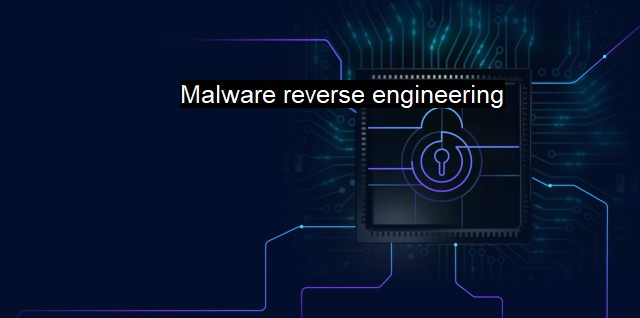What is Malware reverse engineering?
Exploring Malware Reverse Engineering: Understanding the Structure and Function of Threats Reshaping Cybersecurity
Malware reverse engineering is an incredibly significant facet of cybersecurity. it uncovers the inside operations of malicious software. The purpose of deconstructing malware incorporates various aspects. A key focal point is to firmly comprehend its nature - what it essentially accomplishes and how it operates. Additional reasons run from being able to enhance antivirus or antimalware software recognition capacity to identifying who formulated it and potentially even returning knowledge to the initial author.In simpler terms, it's greatly akin to solving a complex puzzle where the corners of the frame are unknown, the pieces are scattered and in a disarray, and the final image doesn't exist. Cybersecurity analysts adopt the role of detectives, who attempt to piece the puzzle to fathom the essence of the malware, ultimately transmuting complex, obfuscated and encrypted code into something that can be comprehended and dealt with.
There are largely diverse strains of malware lingering now, including viruses, worms, Trojans, ransomware and spyware, spanning an immensely wide digital landscape to threaten technological devices. Hence, malware reverse engineering is indispensable for cybersecurity specialists. It isn't always about knowing who's competent in discerning a particular kind of malware; instead, it's more about comprehending what that malware does so we can cease it effectively.
Tools like disassemblers and debuggers are utilised by these specialists to compile human-readable instructions from machine code and system calls, revealing libraries and APIs to provide clues about software behaviour. Interpreting these results requires extensive experience and knowledge about programming, low-level compiled languages, memory and functional operations like network communications or file and process handling.
This task is substantially intricate. Flies in the face of the highly guarded secrets hidden behind sets of seemingly advanced calculations and encoded protocol enigmas. It is an unending virtual battlefield, where every fresh vein of malware may embody new threats or be a variant of an existing one; every practitioner has to scarper to stay abreast. In countering, experts are persistently working on software applications that can detect intrusions and prevent potential dangers.
The fruit of such detailed dive-in inspection premises existence of almost all antivirus and privacy tools. Testing of antivirus products demands samples of various kinds of malware, learnt from previous experiences. By authorising this preemptive strike, we have tactical support to assure our digital lives' security against the undue exploitation of personal data or intrusive attacks that may terminate loss of administrative control.
This reverse engineering operation enables understanding of the limits of malware creations, creation of advanced coding and strategic contractions used to construct it in the first place. As a result, countermeasure strategies can be developed and further improved by analysts or protection vendors. Inducing sophistication, the discipline empowers security practicians to analyse, understand, and develop future-proof solutions that keep advancing in tandem with heinous actioning hackers.
Even though it's stretched out far on the iceberg's underside, malware reverse engineering doubles down by morphing the increasing deluge of malicious software contagion into a manageable crusade against the virtual unknown. Understandably, it is no day at the beach but requires a niche skill set peppered with a whodunit approach to deliver par excellence.
Simultaneously, it expands beyond combating malware, forming warp and weft for the entire cybersecurity fabric, compelling drastic alteration in imminent digital technology landscapes. Fount for the esteemed computational and intricate analysis, this talent ensures we don't lose our way around in the wake of burgeoning digital interference fear.
While innocuous users may stay cloistered from this behind-the-scenes tug of war between hackers and security giants, they eventually snuggle up within the blanket of security that envelops them as antivirus software learns from malware reverse engineering.

Malware reverse engineering FAQs
What is malware reverse engineering?
Malware reverse engineering is the process of analyzing malicious software, such as viruses, Trojans, and worms, to understand how they work, what they do, and how to defend against them.Who performs malware reverse engineering?
Malware reverse engineering is typically performed by cybersecurity professionals, including malware analysts, threat researchers, and computer forensics investigators.Why is malware reverse engineering important?
Malware reverse engineering is crucial for developing effective antivirus and cybersecurity solutions. It enables security experts to identify and analyze threats, understand their behavior, and create countermeasures against them.What are the challenges of malware reverse engineering?
Malware reverse engineering can be difficult and time-consuming, as malware authors often use sophisticated techniques to evade detection and analysis. Additionally, malware can be designed to self-destruct or hide its presence on a system, making it harder to find and analyze.| | A | | | B | | | C | | | D | | | E | | | F | | | G | | | H | | | I | | | J | | | K | | | L | | | M | |
| | N | | | O | | | P | | | Q | | | R | | | S | | | T | | | U | | | V | | | W | | | X | | | Y | | | Z | |
| | 1 | | | 2 | | | 3 | | | 4 | | | 7 | | | 8 | | |||||||